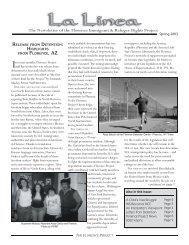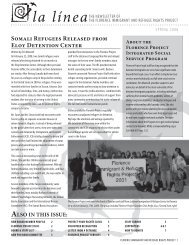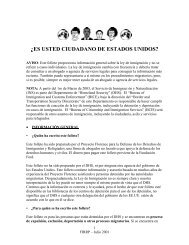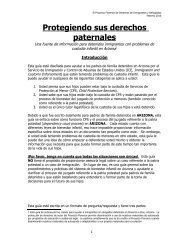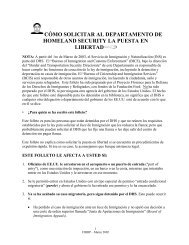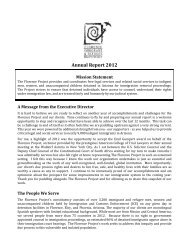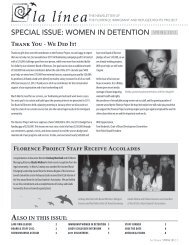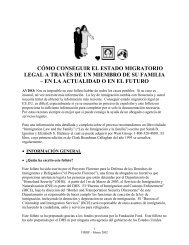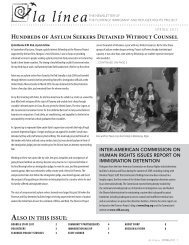HOW TO APPLY FOR ASYLUM - The Florence Project
HOW TO APPLY FOR ASYLUM - The Florence Project
HOW TO APPLY FOR ASYLUM - The Florence Project
Create successful ePaper yourself
Turn your PDF publications into a flip-book with our unique Google optimized e-Paper software.
definition of a “refugee” as defined in section 101(a)(42) of the INA. You can only be granted asylum if at<br />
least one of the reasons someone harmed or may harm you is because of your race, religion, nationality,<br />
political opinion (or a political opinion someone thinks you have), or the fact that you are part of some<br />
particular social group.<br />
If you are granted asylum, you will be allowed to stay in the United States legally and to get a work permit.<br />
Your husband or wife and your unmarried children under age 21 who are in the U.S. can also get legal status<br />
as asylees if you include them on your asylum application. If they are outside the U.S., you can file papers to<br />
allow them to come to the U.S. after you are granted asylum. If you are granted asylum, you may later apply<br />
to be a lawful permanent resident and, eventually, a U.S. citizen.<br />
• What is withholding of removal under INA section 241(b)(3)<br />
Withholding of removal is a type of legal protection some people may be able to get instead of asylum and is<br />
defined at section 241(b)(3)(A) and (B) of the INA. For reasons we explain in more detail later – for example,<br />
either applying for asylum more than one year after entering the United States and you do not qualify for an<br />
exception or because of certain criminal convictions – some people are not “eligible” or “qualified” for<br />
asylum. Also, even if a particular criminal conviction or bad act does not prevent you from applying for<br />
asylum, the Immigration Judge may decide to deny your asylum application because of it. In such situations,<br />
“withholding” may be the only way to avoid removal.<br />
Withholding is like asylum in that it keeps you from being sent back to your country, and it means you may live<br />
and work legally in the U.S. You apply for withholding the same way you apply for asylum, using the same<br />
application form. But there are important differences. First, it is harder to be granted withholding. You have to<br />
show more than that there is a good chance you will be persecuted on account of your race, religion, political<br />
opinion (or a political opinion someone thinks you have), or the fact that you are part of some particular social<br />
group if you go back to your country. You have to show that your life or freedom will be in danger, and you<br />
have to show that this is likely to happen (not just that it is possible). Second, if you are granted this form of<br />
protection, it only means you cannot be sent back to the country where you face danger. If another country is<br />
willing to take you, the United States can send you there. Third, if conditions change in your country so that<br />
DHS believes it is safe for you to go back, DHS could start a new case in immigration court to try to convince a<br />
judge that you should be sent back. Finally, withholding does not get you permanent residence, does not allow<br />
you to immigrate your family, and does not lead to becoming a U.S. citizen.<br />
• What is withholding or deferral of removal under the Convention Against Torture<br />
Withholding of removal under the Convention Against Torture (CAT) is a type of legal protection some people<br />
may be able to get if they show that it is more likely than not that they would be tortured by the government or<br />
people working for or with the consent of the government if they were returned to a particular country.<br />
“Torture” is defined in Article 1 of the Convention against Torture and at 8 Code of Federal Regulations (CFR)<br />
sections 208.18(a) and 1208.18(a). Withholding of removal under the CAT is very much like withholding of<br />
removal under section 241(b)(3) of the INA in that, if you are granted this form of protection, it only means you<br />
cannot be sent back to the country where you face torture. However, there is no requirement that the feared<br />
torture be related to a protected reason as required for asylum or withholding under INA section 241(b)(3). If<br />
another country is willing to take you, the United States can send you there. Also, if conditions change in your<br />
country so that DHS believes it is safe for you to go back, DHS could start a new case in immigration court to<br />
try to convince a judge that you should be sent back. Finally, withholding under the CAT does not get you<br />
permanent residence, does not allow you to immigrate your family, and does not lead to becoming a U.S.<br />
Page 3 of 49<br />
FIRRP- last update June 2007



